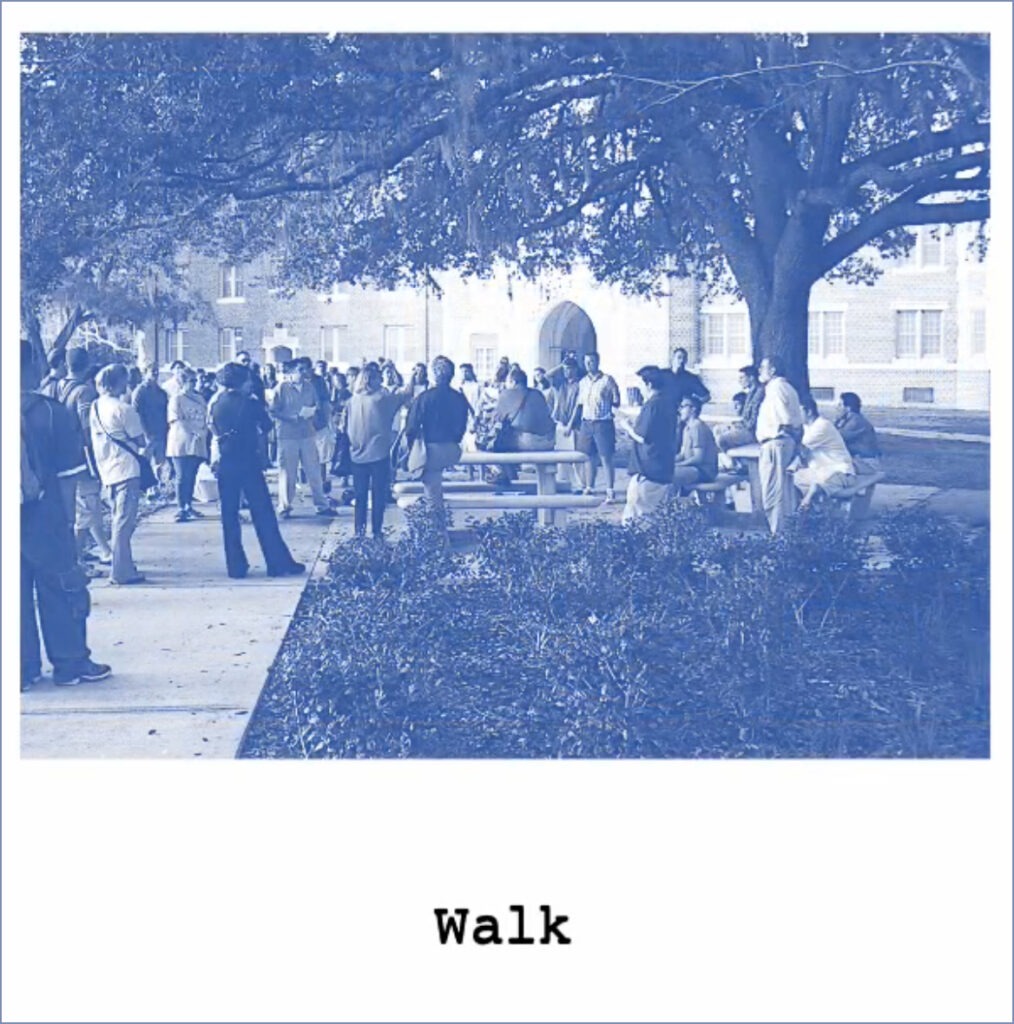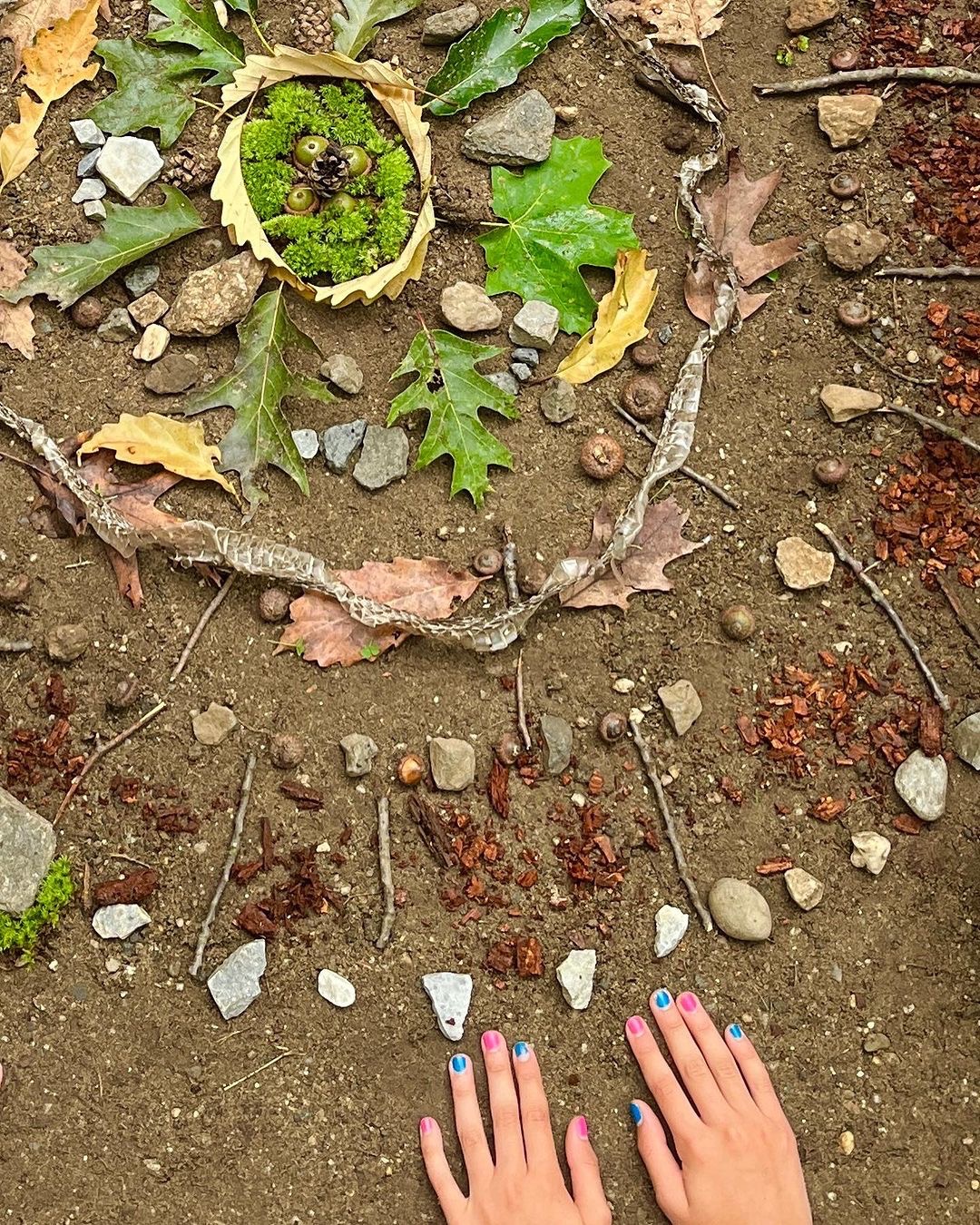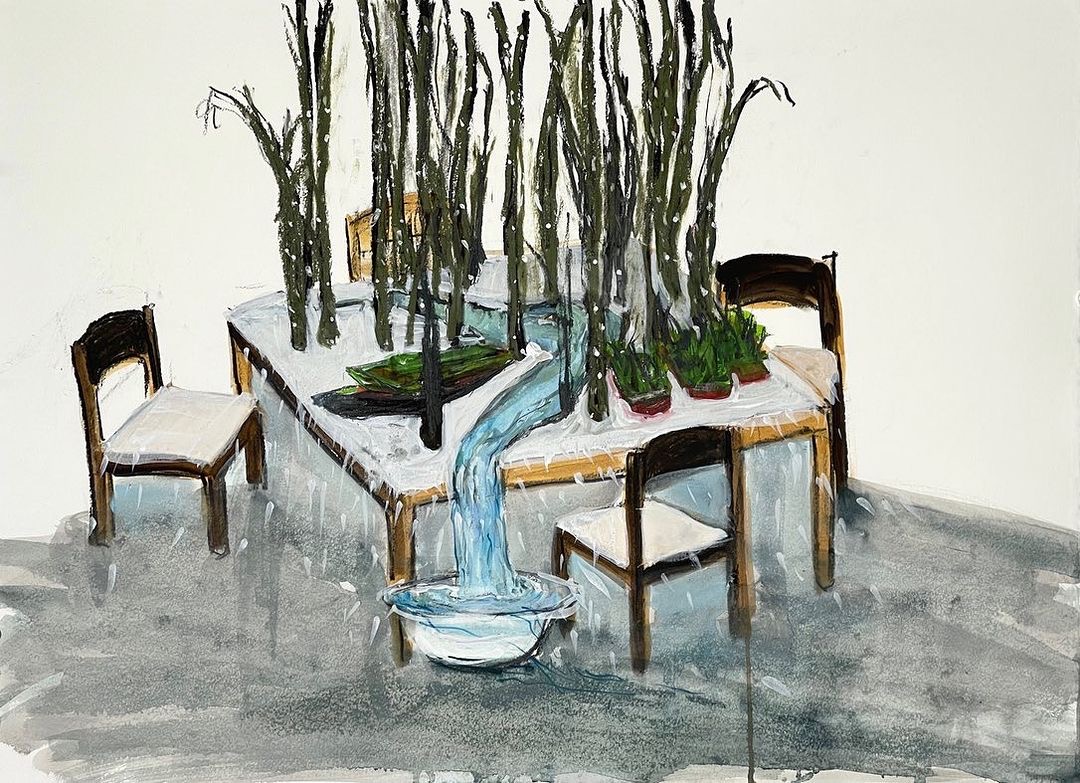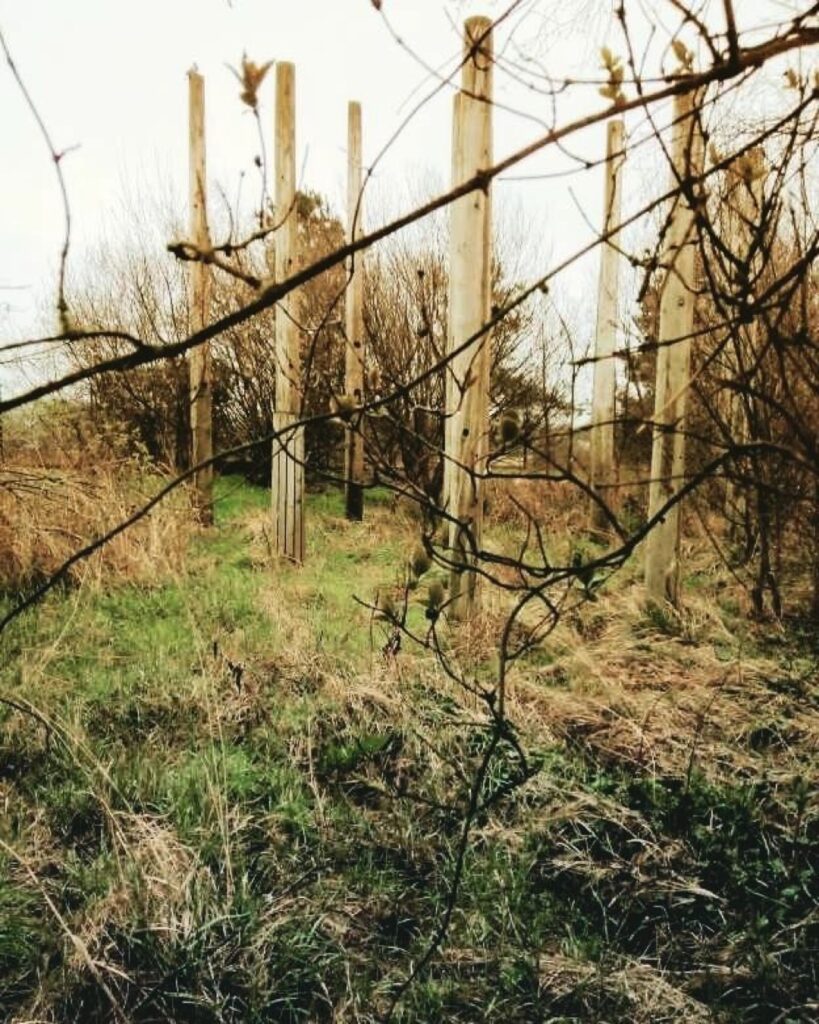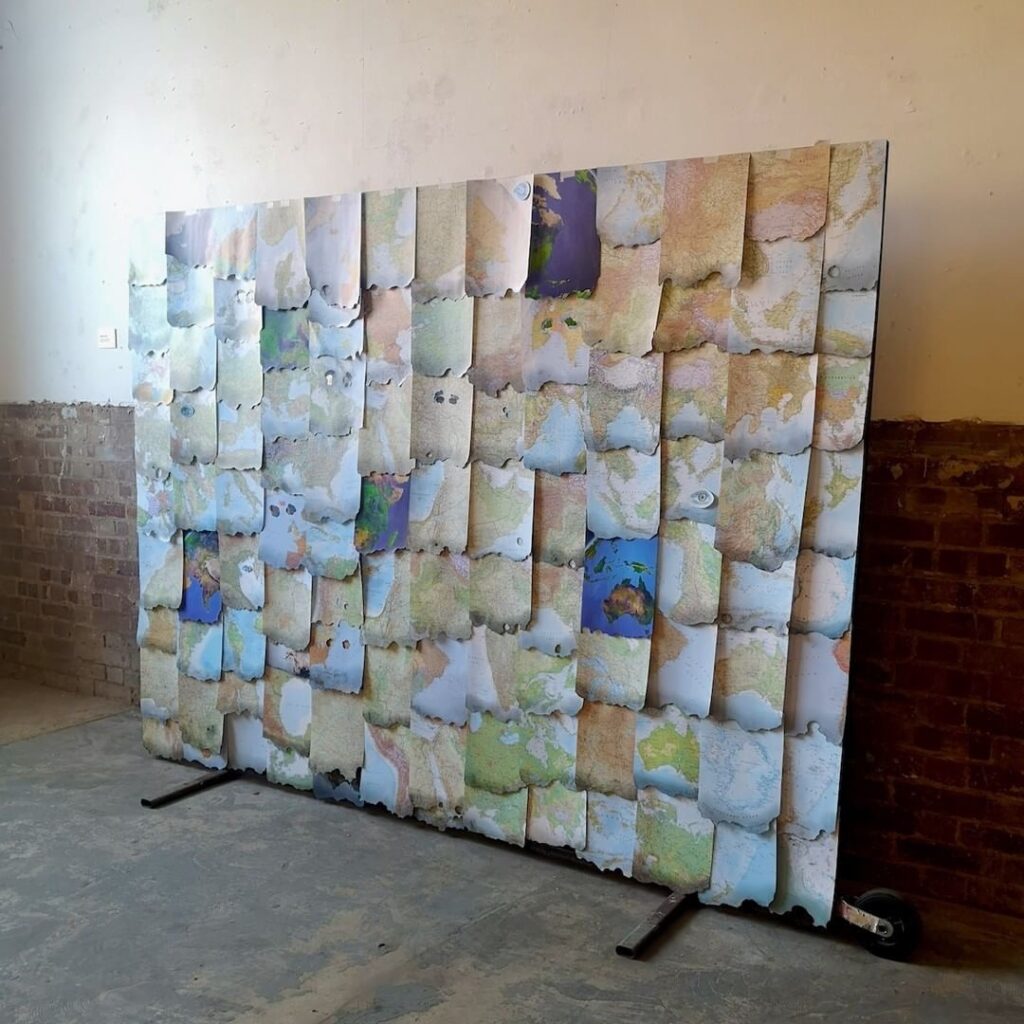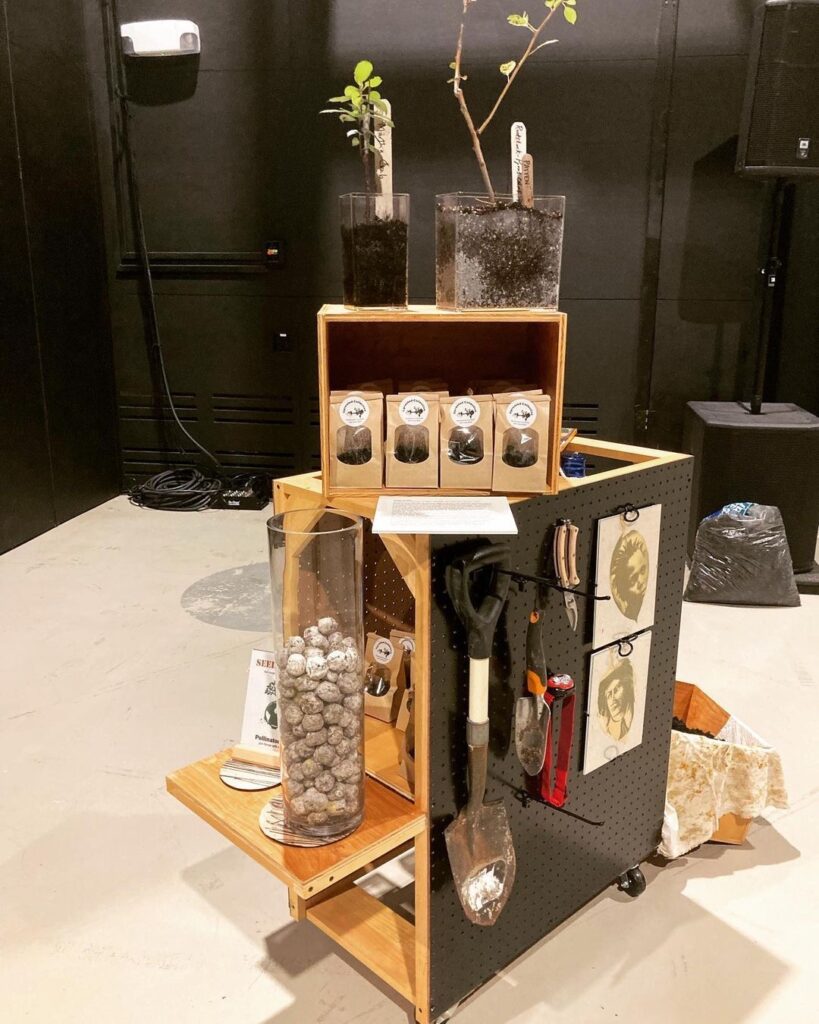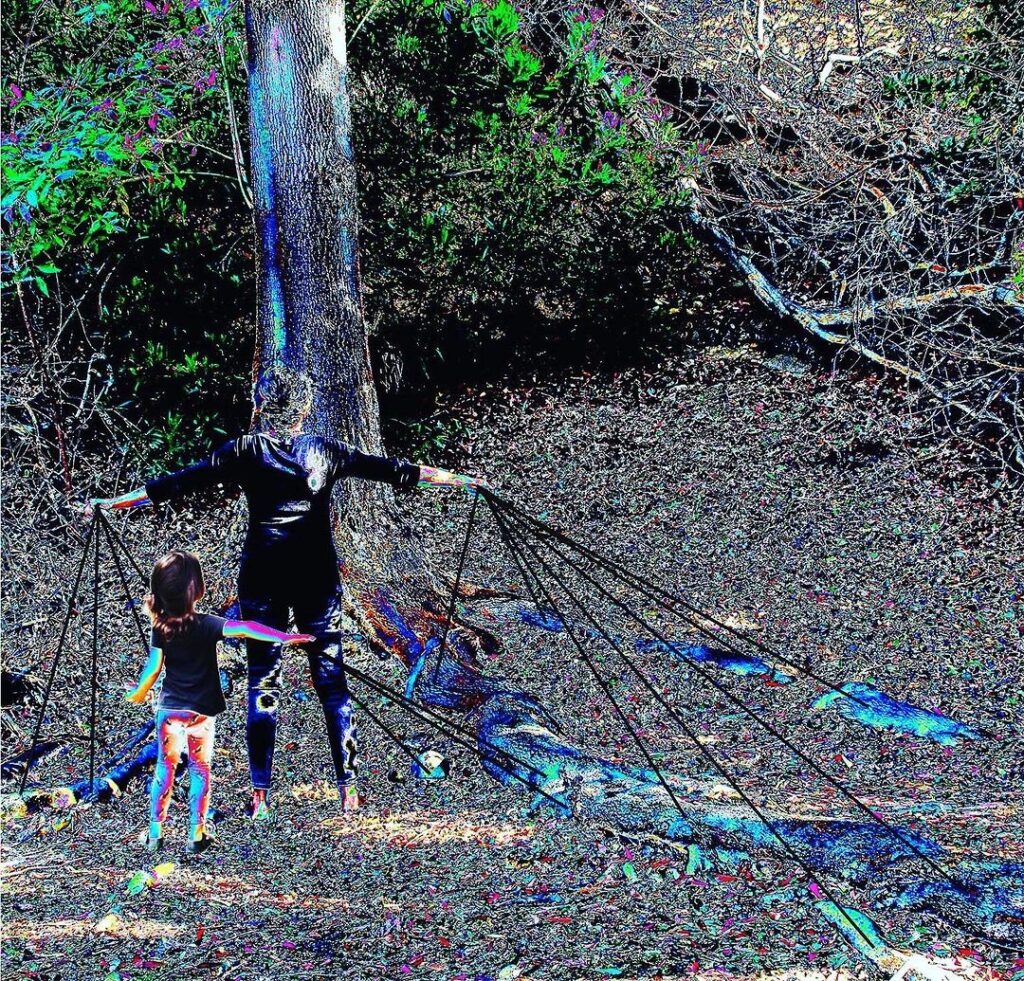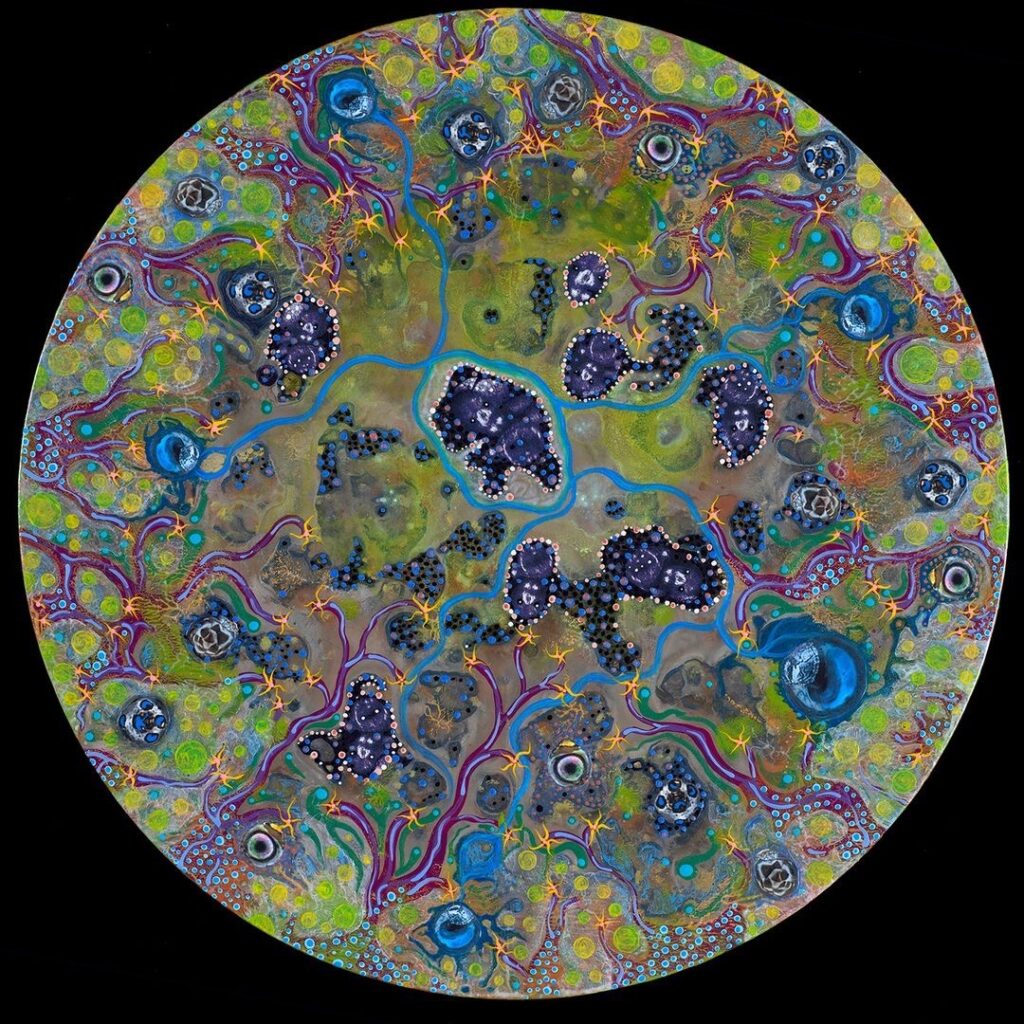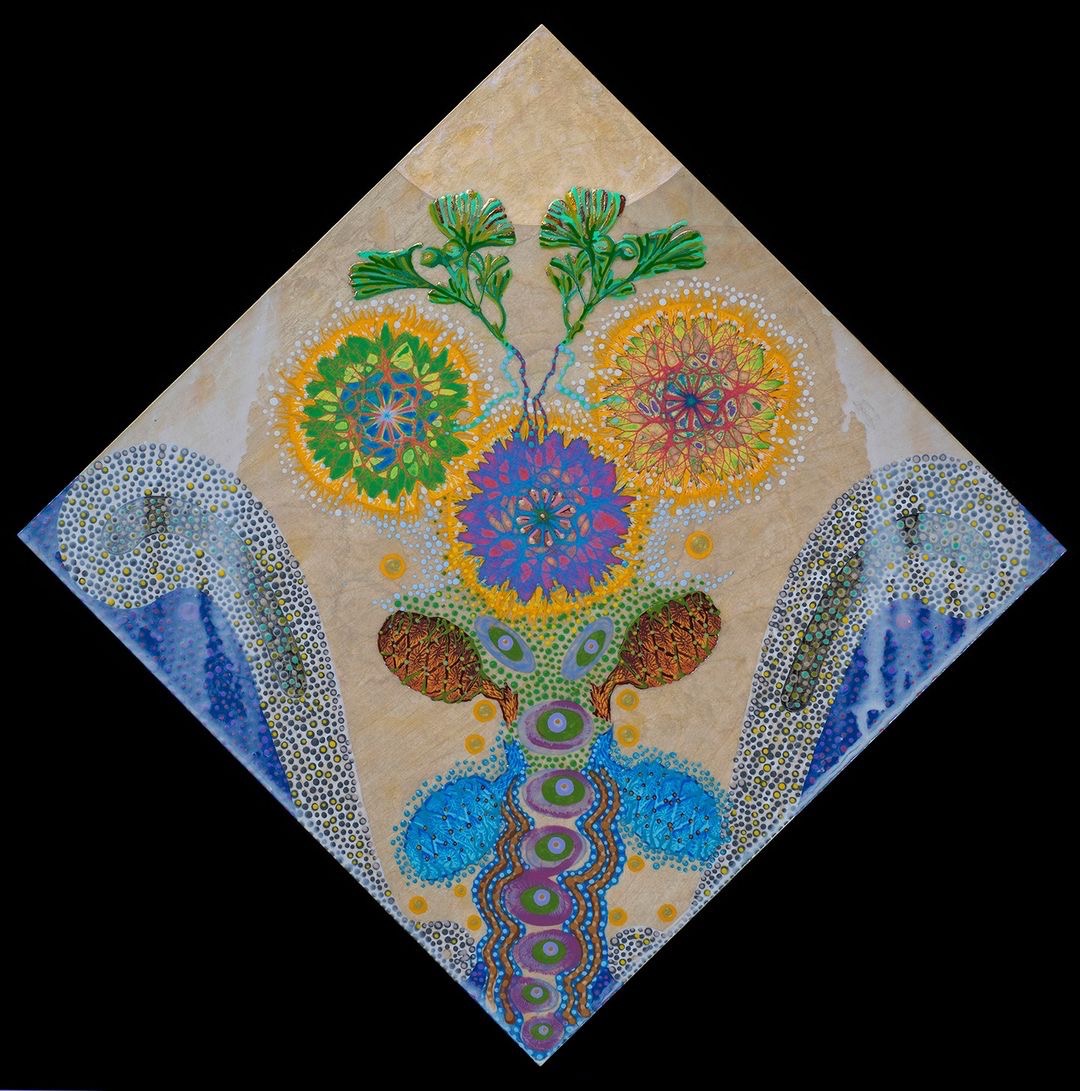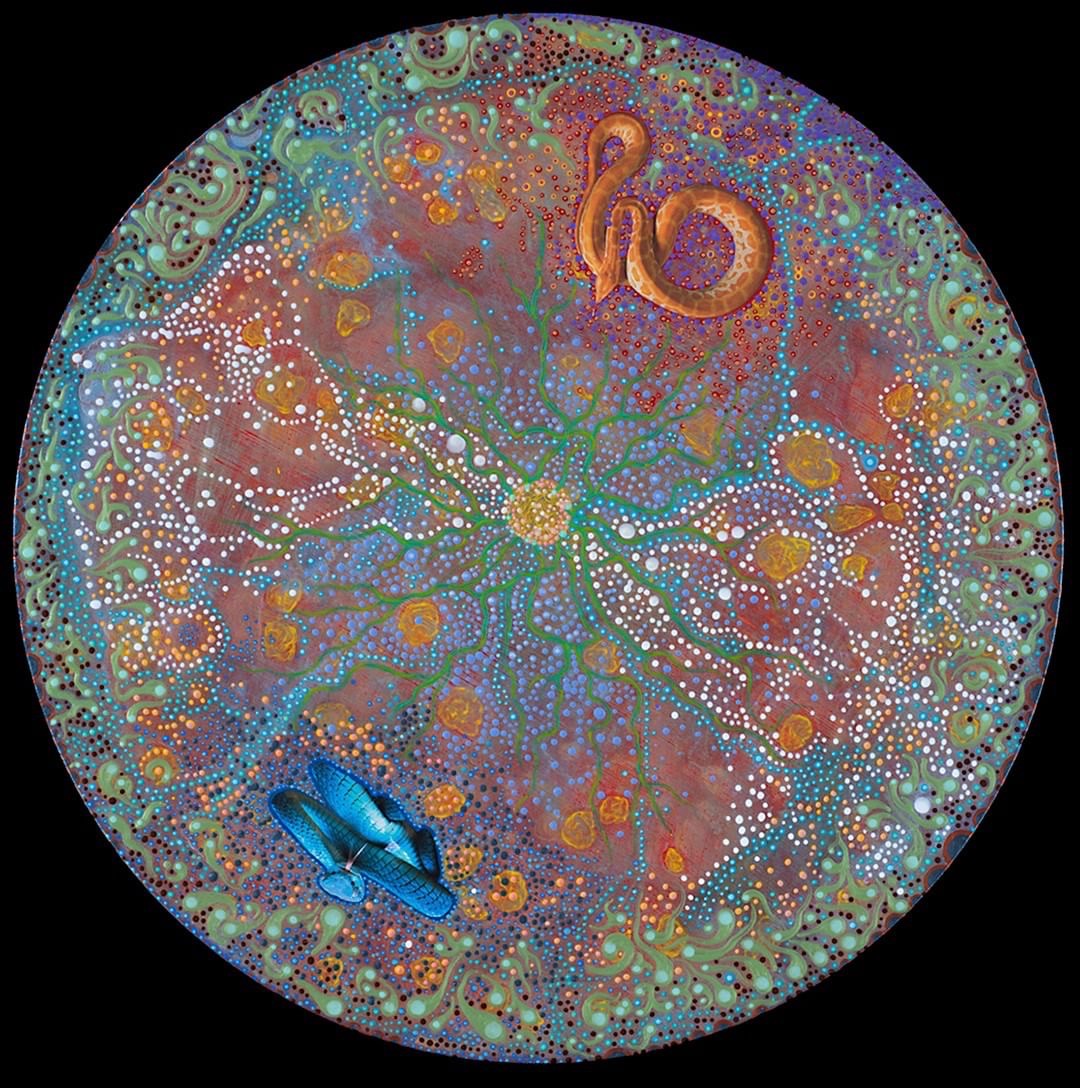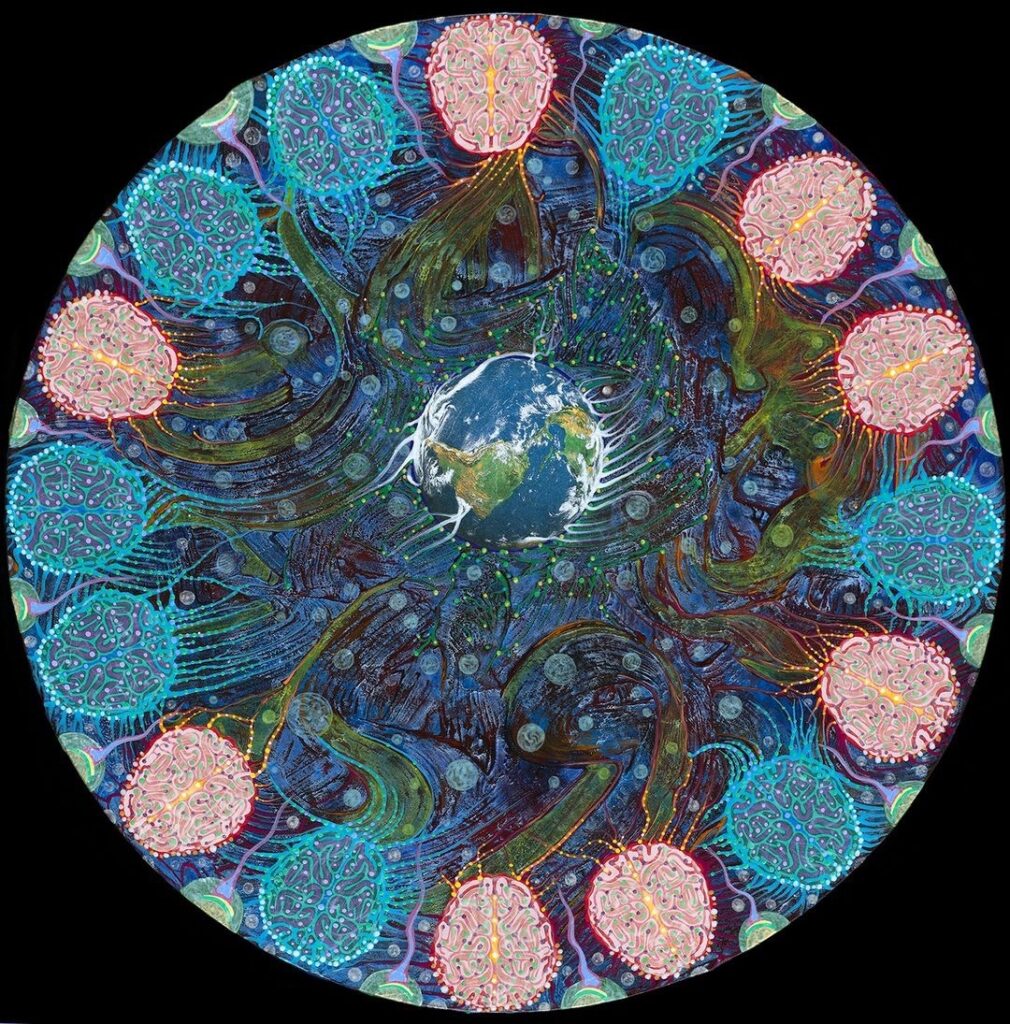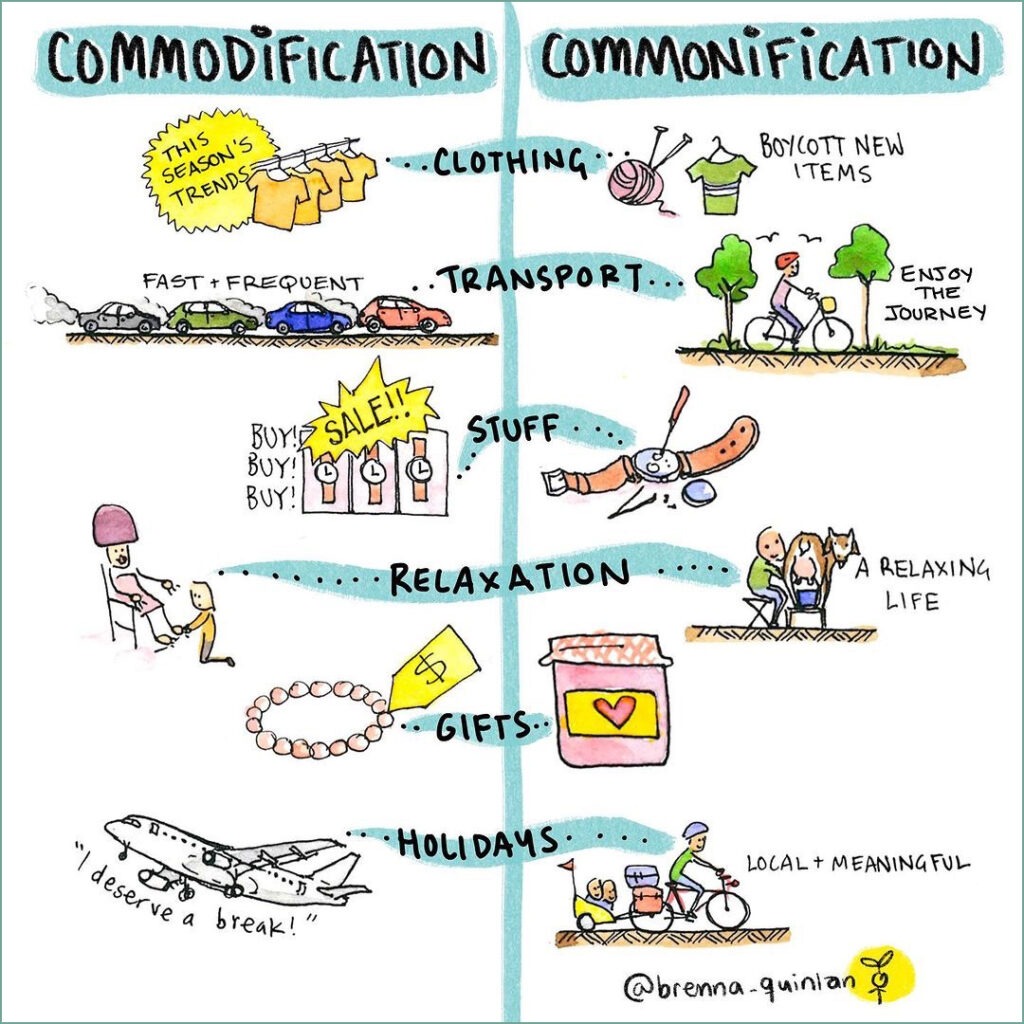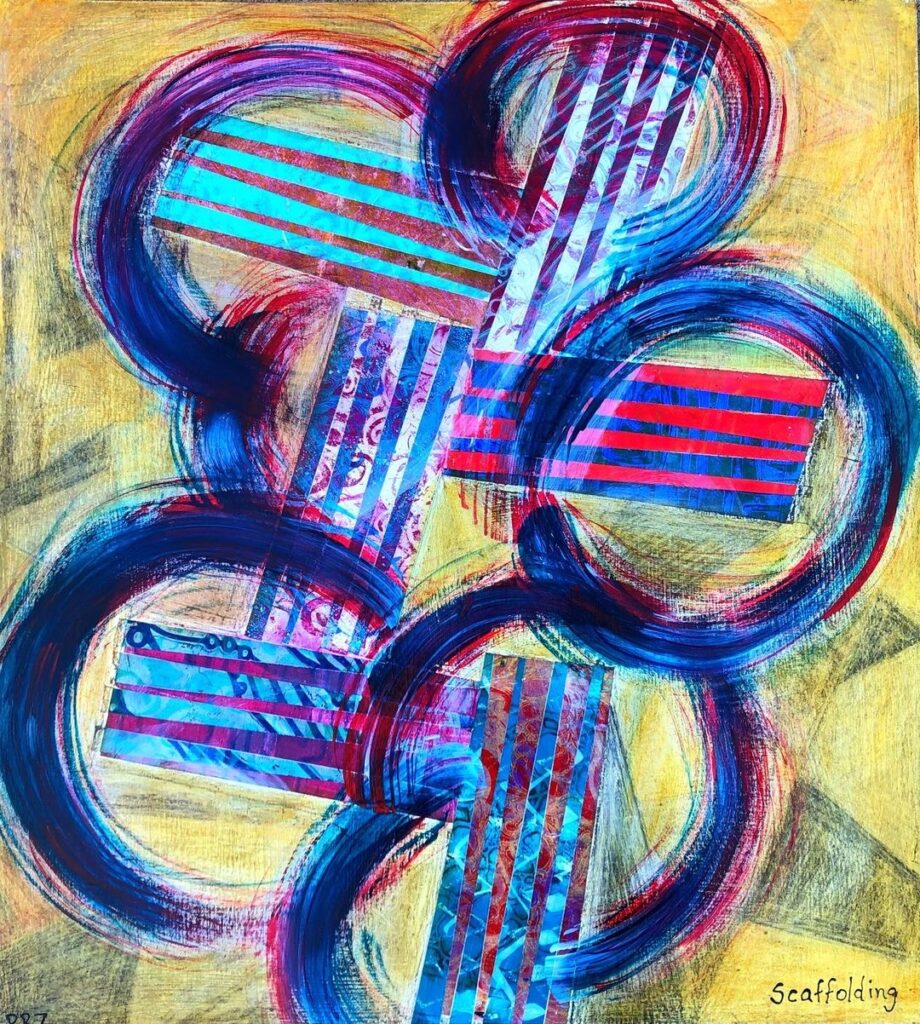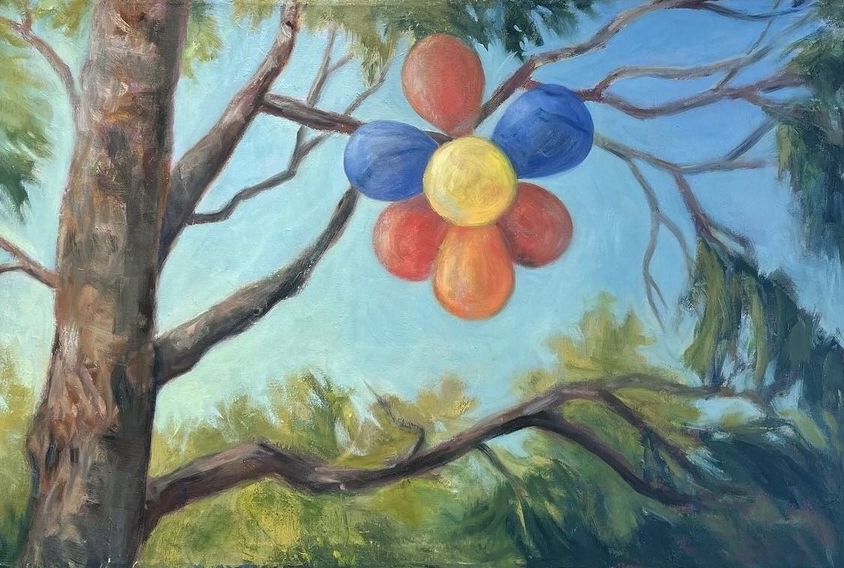“Education—particularly early-childhood education—not only sets the foundation for who we become in later life, but also shapes society as a whole. If we want a more resilient society and more resilient communities, we have to plant the seeds today in students both young and old. We need education that trains people in both community and personal resilience-building.”
– Richard Heinberg
Community Resilience and Education Online Exhibition
- Online Exhibition opened
Artists
Kirsten Aaboe, Allison Lee Cousland, Yvonne C Espinoza, Ries Faison, Diane Farris, Jacqui Jones, Deborah Kennedy, Celia Kettle, Rosalind Lowry, Quin de la Mer, Kim Tanzer, Brenna Quinlan, Peggy Rose, Susan Smith, Teresa Stern, Marcela Villasenor, Karen Viola, Gordon Wood.
.Exhibition
Walk Talk Dream Share
Instagram Reel
1996-present
This Reel unspools a series of iterative projects involving community members and architecture students co-creating their local environment. I think of the process as a collaborative ritual involving four stages: walking, talking, dreaming, and sharing. Following the work of anthropologist Victor Turner, I have sought to evoke liminal experiences, where experts and community members merge with each other and the object of their interest—the shared environment.
Beginning in 1996, these projects include participatory design techniques like walking tours and discussions, photo collection, then drawing and model making, urban design explorations, exhibits, and presentations. In each case, multiple intelligences are engaged, and learning is set in the community, not the classroom. The role of expert is upended, as community members and environmental designers often exchange roles.
Artists and critics inspiring this work include Michael Brenson, Mark Dion, Suzi Gablik, Helen & Newton Harrison, Mildred Howard, Mary Jane Jacob, Suzanne Lacy, and Estella Conwill Májozo.
As Richard Heisenberg says, “Resilience will therefore require engagement of all the individual’s multiple intelligences (linguistic, spatial, mathematical, bodily, interpersonal, intrapersonal, musical, and naturalistic). Neuroscience research into learning suggests that activities that move beyond linguistic and numeric drills—beyond classrooms and computers and into nature—may be especially effective at engaging the whole person.”
Over the decades, some of the architecture students involved in these projects have themselves become community advocates, while the community activists have come to speak for good, inclusive urban design. This creative problem-solving is called Design. We can design our lives, in all their different facets, to sit more on the 'commonification' side of the page. And by strengthening that practice, we'll find a whole host of unintended pleasant surprises waiting for us. I mean, who doesn't love free lemons? What things do you do that are outside the norm? And why do you love doing it your way?
Beginning in 1996, these projects include participatory design techniques like walking tours and discussions, photo collection, then drawing and model making, urban design explorations, exhibits, and presentations. In each case, multiple intelligences are engaged, and learning is set in the community, not the classroom. The role of expert is upended, as community members and environmental designers often exchange roles.
Artists and critics inspiring this work include Michael Brenson, Mark Dion, Suzi Gablik, Helen & Newton Harrison, Mildred Howard, Mary Jane Jacob, Suzanne Lacy, and Estella Conwill Májozo.
As Richard Heisenberg says, “Resilience will therefore require engagement of all the individual’s multiple intelligences (linguistic, spatial, mathematical, bodily, interpersonal, intrapersonal, musical, and naturalistic). Neuroscience research into learning suggests that activities that move beyond linguistic and numeric drills—beyond classrooms and computers and into nature—may be especially effective at engaging the whole person.”
Over the decades, some of the architecture students involved in these projects have themselves become community advocates, while the community activists have come to speak for good, inclusive urban design. This creative problem-solving is called Design. We can design our lives, in all their different facets, to sit more on the 'commonification' side of the page. And by strengthening that practice, we'll find a whole host of unintended pleasant surprises waiting for us. I mean, who doesn't love free lemons? What things do you do that are outside the norm? And why do you love doing it your way?
2023
- Kim Tanzer
I Love You Earth
Cyanotype on paper
Wildflower petals, Umbria Italy, fresh water stream, spring sunlight, light breeze, digital art, sound art
2023
When I collaborate with the natural world using cyanotype art-making methods, I always think how great it would be for young people to have this experience. It’s easy to prepare the paper or fabric ahead of time to bring with you into the wild places. Collaborating with the elements to bring a work of art into being is a wonderful way to intimately bond with the more-than-human residents we share this world with. The activity itself is meditative; the changing circumstances allow the maker to practice adaptability as the uncertain future of the artwork cannot be controlled, and it engages all the senses.
To quote Richard Heinberg “Neuroscience research into learning suggests that activities that move beyond linguistic and numeric drills-beyond classrooms and computers and into nature-may be especially effective at engaging the whole person.” “If we want a more resilient society and more resilient communities, we have to plant the seeds today in students both young and old.”
To quote Richard Heinberg “Neuroscience research into learning suggests that activities that move beyond linguistic and numeric drills-beyond classrooms and computers and into nature-may be especially effective at engaging the whole person.” “If we want a more resilient society and more resilient communities, we have to plant the seeds today in students both young and old.”
2023
- Quin de la Mer
Weeping Fig with Book and Bags
Photograph
Richard Heinberg’s perspective on the centrality of early childhood education in building a resilient society and his examples brought to mind a local camp and the image of a classic child’s lunchbox. This summer, I prepared daily lunchboxes for a camp with strong ties to nature and to the children’s sense of well-being, both aspects of resilience education. I strove to avoid single use plastic and have a renewed appreciation of just one of the challenges parents face every school day.
In Weeping Fig with Book and Bags, a tree rises in front of paper lunch bags. The “sky” background is composed of plastic, persisting. The book illustration of trees in the foreground references the lively study of natural systems. The embrace of recent books on forest systems by scientist/scholars like Robin Wall Kimmerer and Suzanne Simard is encouraging, as is the community gathering around What’s Next for Earth.
In Weeping Fig with Book and Bags, a tree rises in front of paper lunch bags. The “sky” background is composed of plastic, persisting. The book illustration of trees in the foreground references the lively study of natural systems. The embrace of recent books on forest systems by scientist/scholars like Robin Wall Kimmerer and Suzanne Simard is encouraging, as is the community gathering around What’s Next for Earth.
2023
- Diane Farris
Earth and Heaven. No 1.
1: Earth and Heaven
2 & 3: Eco Curio
4 & 5: Paperbark book (wip)
6: Tiny Sacred Art Journal (wip)
7: Vine and feathers
8: Earth and Heaven
We need education that trains people in both community and personal resilience-building.’ ~Richard Heinberg.
Can our children be taught personal resiliency so that our entire communities will become more resilient in the face of great change: Adapting to uncertainty and adversity, so that a new strength can emerge within individuals and society. Perhaps the best way to cultivate resiliency is to create the social and environmental conditions where an individual can greet every day ~ And situation ~ In total freedom and joy, with a sense of wonder and self love.
So that in the words of John O’Donohue: ‘May you experience each day as a sacred gift woven around the heart of wonder.’ Because: ‘No one else can see the world the way you see it. No one else can feel your life the way you feel it.’
It's said that the way to truly grow is to break free from ‘the chains of stability’ and dive into the Unknown. And even though diving into the ‘Unknown’ can be quite disquieting: It’s a path that creatives need to take.
Ever since I wedged a vine with feathers into one of my driftwood ‘Eco Curios’ I’ve been fascinated with this ‘motif.’ Not understanding ‘why’ initially wasn’t all that important as I simply loved making and playing with them. But after a few weeks, the unknown ’why’ DID matter. Till one morning, just as I was waking, I finally ’got it.’
To be continued.
Can our children be taught personal resiliency so that our entire communities will become more resilient in the face of great change: Adapting to uncertainty and adversity, so that a new strength can emerge within individuals and society. Perhaps the best way to cultivate resiliency is to create the social and environmental conditions where an individual can greet every day ~ And situation ~ In total freedom and joy, with a sense of wonder and self love.
So that in the words of John O’Donohue: ‘May you experience each day as a sacred gift woven around the heart of wonder.’ Because: ‘No one else can see the world the way you see it. No one else can feel your life the way you feel it.’
It's said that the way to truly grow is to break free from ‘the chains of stability’ and dive into the Unknown. And even though diving into the ‘Unknown’ can be quite disquieting: It’s a path that creatives need to take.
Ever since I wedged a vine with feathers into one of my driftwood ‘Eco Curios’ I’ve been fascinated with this ‘motif.’ Not understanding ‘why’ initially wasn’t all that important as I simply loved making and playing with them. But after a few weeks, the unknown ’why’ DID matter. Till one morning, just as I was waking, I finally ’got it.’
To be continued.
2023
- Alison Lee Cousland
Creative Campers Mandala
Collaborative piece
Natural found object
3' in diameter
As a contribution to the What's Next for Earth art call about Community Resilience and Education based on Richard Heinberg's Think Resilience course, I thought I'd share a collaborative piece, "Creative Campers Mandala," which I organized this summer with kids at #cranberrylakepreserve. I encouraged each child to be in charge of gathering a bunch of the same type of natural object of their own choosing. The kids then took turns growing and diversifying the mandala from the center, integrating their own collection with that of others. It was a rewarding experience for all, especially me. Even the teenage counsellors got into it, adding the snake skin contribution from the nature center.
The size of the mandala was approximately 3 feet in diameter but variable and of course ephemeral in the shifting winds. I couldn't resist growing it bigger with the children's own hands, which is where our future lies...
As Heinberg asserts: "Adaptability in an uncertain future implies education for the entire brain and all the senses. Resilience will therefore require engagement of all of the individual’s multiple intelligences... Neuroscience research into learning suggests that activities that move beyond linguistic and numeric drills—beyond classrooms and computers and into nature—may be especially effective at engaging the whole person."
The size of the mandala was approximately 3 feet in diameter but variable and of course ephemeral in the shifting winds. I couldn't resist growing it bigger with the children's own hands, which is where our future lies...
As Heinberg asserts: "Adaptability in an uncertain future implies education for the entire brain and all the senses. Resilience will therefore require engagement of all of the individual’s multiple intelligences... Neuroscience research into learning suggests that activities that move beyond linguistic and numeric drills—beyond classrooms and computers and into nature—may be especially effective at engaging the whole person."
2023
- Karen Viola
Nature-based Montessori resilience education
Watercolor, charcoal, and water soluble crayon on wove paper
22 x 30 in (56 x 76 cm)
2023
Community resilience starts with education fostering cooperation, life skills, psychological strength while developing insight into social and ecological systems’
Richard Heinberg, Post Carbon Institute
The self-directed, hands-on supportive learning system first developed by Maria Montessori here expanded to cover natural systems and developing resilience.
The self-directed, hands-on supportive learning system first developed by Maria Montessori here expanded to cover natural systems and developing resilience.
2023
- Dorothy Ries Faison
Remembering The Irish Woodlands
Installation
Forest Service Northern Ireland
2018
For the last 2 years, I've been involved in @whatsnextforearth programme with The Millennium Alliance for Humanity and the Biosphere, a Stanford University initiative.
This image is for the Community Resilience and Education program.
Ash Dieback disease is changing the landscape and habitat for wildlife across Ireland, and the governments in the North and South have collaborated on an education program for people across the island to report any infected Ash trees they see. A new app has been developed to stop the spread of the disease.
This image is of a work based on the disappearing landscape of Ireland and the app. It is easily downloaded and easy to use.
Ash Dieback disease is changing the landscape and habitat for wildlife across Ireland, and the governments in the North and South have collaborated on an education program for people across the island to report any infected Ash trees they see. A new app has been developed to stop the spread of the disease.
This image is of a work based on the disappearing landscape of Ireland and the app. It is easily downloaded and easy to use.
2023
- Rosalind Lowry
The World is Watching
Interactive artwork
Burnt world maps
8 feet x 6 feet
2023
‘If we want a more resilient society and more resilient communities, we have to plant the seeds today in students both young and old. We need education that trains people in both community and personal resilience-building'.
~ Richard Heinberg, Post Carbon Institute.
My recent artwork THE WORLD IS WATCHING illustrates how the arts can play an important role in community resilience and education.
The large-scale participatory artwork was created from burnt world maps. It encouraged the public to respond to two questions: Q1 ‘The World Is Watching’ the climate emergency, what do you see? Q2 What’s one action you can take to improve the Earth’s health?
The public could then look through eye holes burnt into the maps to discover how people perceive the climate crisis and what steps they are taking to help.
The World is Watching encouraged participation, dialogue, and information exchange in ways that are engaging, informative, and accessible to all.
My recent artwork THE WORLD IS WATCHING illustrates how the arts can play an important role in community resilience and education.
The large-scale participatory artwork was created from burnt world maps. It encouraged the public to respond to two questions: Q1 ‘The World Is Watching’ the climate emergency, what do you see? Q2 What’s one action you can take to improve the Earth’s health?
The public could then look through eye holes burnt into the maps to discover how people perceive the climate crisis and what steps they are taking to help.
The World is Watching encouraged participation, dialogue, and information exchange in ways that are engaging, informative, and accessible to all.
2023
- Jacqui Jones
Guerilla garden cart
Seed bombs, mushroom/holy basil compost, seed saver library, reforestation grafted fruit trees, and the tools for radical gardening.
The portraits are chlorophyll prints on hosta
Nomadic gardening and education.
The grafted trees are part of a reforestation project, and a grafting of fruit trees workshop.
The portraits are part of a series of garden activists: Gerrard Winstanley 1600s founder of the Diggers, and agrarian activist; Chido Govera, a Zimbabwe farmer, activist and educator. They are two of six in the series.
Absence of Urgency 2023 Intermedia Faculty Symposium IMRC, University of Maine.
The grafted trees are part of a reforestation project, and a grafting of fruit trees workshop.
The portraits are part of a series of garden activists: Gerrard Winstanley 1600s founder of the Diggers, and agrarian activist; Chido Govera, a Zimbabwe farmer, activist and educator. They are two of six in the series.
Absence of Urgency 2023 Intermedia Faculty Symposium IMRC, University of Maine.
2023
- Susan Smith
Interconnect
digital collage
2023
The most important legacy to our children is to teach them to understand and interconnect with nature in order to protect them for their own survival.
”particularly early childhood education - not only sets the foundation for who we become in later life, but also shapes society as a whole. If we want a more resilient society and more resilient communities, we have to plant the seeds today in students, both young and old. We need an education that trains people in both community and personal resilience building.” Richard Heinberg.
”particularly early childhood education - not only sets the foundation for who we become in later life, but also shapes society as a whole. If we want a more resilient society and more resilient communities, we have to plant the seeds today in students, both young and old. We need an education that trains people in both community and personal resilience building.” Richard Heinberg.
2023
- Marcela Villaseñor
Gold Leaf II
Watercolor
Papier maché from egg boxes and leaves with metallic paint on canvas.
20 x 20 cm
This artwork forms part of a series entitled ’The Cycle of Life’. I love gardening and watching the plants grow, and one day, while sweeping my patio, I noticed leaves that had blown out from the flower bed; they were in different stages of decomposition, but all of them had a captivating, fragile beauty. I had already been using recycled materials in my artworks, which reminded me of the natural recycling process, which constantly occurs in nature. Living in a big city, we don’t often see this process, as the leaves are quickly swept away to keep the streets clean. It’s so obvious and simple, yet we often aren’t aware of it. It made me think of how important it is to observe and experience nature.
The Think Resilience course talks about this understanding of nature as having an important role in education.
“Activities that build creativity, cooperation, self-reliance, and leadership aid personal resilience. And so does a practical understanding of basic systems—natural ecosystems, as well as human food, water, and energy systems.”
I couldn’t resist painting them gold and elevating them to the status of an art object to give them visibility and value within our consumer society.
The Think Resilience course talks about this understanding of nature as having an important role in education.
“Activities that build creativity, cooperation, self-reliance, and leadership aid personal resilience. And so does a practical understanding of basic systems—natural ecosystems, as well as human food, water, and energy systems.”
I couldn’t resist painting them gold and elevating them to the status of an art object to give them visibility and value within our consumer society.
2023
- Celia Kettle
The power within our grasp?
Digital photomontage
I was cracked open some time ago to hear the native perspective of thinking ahead seven generations when making decisions. How to provide, teach, build, and support the strength and resilience to meet the insurmountable and survive is our responsibility for those generations here and to come.
“Resilience will therefore require engagement of all of the individual’s multiple intelligences (linguistic, spatial, mathematical, bodily, interpersonal, intrapersonal, musical, and naturalistic). Neuroscience research into learning suggests that activities that move beyond linguistic and numeric drills—beyond classrooms and computers and into nature—may be especially effective at engaging the whole person.”
“Resilience will therefore require engagement of all of the individual’s multiple intelligences (linguistic, spatial, mathematical, bodily, interpersonal, intrapersonal, musical, and naturalistic). Neuroscience research into learning suggests that activities that move beyond linguistic and numeric drills—beyond classrooms and computers and into nature—may be especially effective at engaging the whole person.”
2023
- Kirsten Aaboe
Stardust’s Enactive Emergence
Acrylic Collage on Panel
20" x 20"
“Adaptability in an uncertain future implies education for the entire brain and all the senses. Neuroscience research into learning suggests that activities that move beyond linguistic and numeric drills—beyond classrooms and computers and into nature—may be especially effective at engaging the whole person.” Richard Heinberg
“The fields responsible for the development and maintenance of bodily form in plants and animals are called morphogenetic fields. In animals, the organization of behavior and mental activity depends on behavioral and mental fields. The organization of societies and cultures depends on social and cultural fields. All these kinds of organizing fields are morphic fields.” “ Creativity is a profound mystery precisely because it involves the appearance of patterns that have never existed before. Our usual way of explaining things is in terms of pre-existing causes: The cause somehow contains the effect; the effect somehow follows the cause. Creativity thus consists in the manifestation or discovery of this pre-existing possibility.” - Rupert Sheldrake
Art as a system resonates as a morphic field probabilistically and has field-like connections between members of social groups, communities, then it can expand out, within and throughout civilization as learning, conditioning in integral patterns.
Art is a medium of attractors stimulating critical thinking in a nonlinear dynamic of openness for transmutation, as does spending time in nature; for Human art gives us glimpses of the truth that art is nature.
Creative, Art Practice as tools and resources for adaptability nurtures reciprocal relationships that support increased awareness and resilience. The creative process and exposure to art opens one up to asking the right questions for deliberation, dialogue, learning, and transformations.
“The fields responsible for the development and maintenance of bodily form in plants and animals are called morphogenetic fields. In animals, the organization of behavior and mental activity depends on behavioral and mental fields. The organization of societies and cultures depends on social and cultural fields. All these kinds of organizing fields are morphic fields.” “ Creativity is a profound mystery precisely because it involves the appearance of patterns that have never existed before. Our usual way of explaining things is in terms of pre-existing causes: The cause somehow contains the effect; the effect somehow follows the cause. Creativity thus consists in the manifestation or discovery of this pre-existing possibility.” - Rupert Sheldrake
Art as a system resonates as a morphic field probabilistically and has field-like connections between members of social groups, communities, then it can expand out, within and throughout civilization as learning, conditioning in integral patterns.
Art is a medium of attractors stimulating critical thinking in a nonlinear dynamic of openness for transmutation, as does spending time in nature; for Human art gives us glimpses of the truth that art is nature.
Creative, Art Practice as tools and resources for adaptability nurtures reciprocal relationships that support increased awareness and resilience. The creative process and exposure to art opens one up to asking the right questions for deliberation, dialogue, learning, and transformations.
2023
- Gordon Wood
Munificence: Feminine Light Transforms
Acrylic Collage on Panel
20"x20"
“Adaptability in an uncertain future implies education for the entire brain and all the senses. Neuroscience research into learning suggests that activities that move beyond linguistic and numeric drills—beyond classrooms and computers and into nature—may be especially effective at engaging the whole person.” Richard Heinberg
“The fields responsible for the development and maintenance of bodily form in plants and animals are called morphogenetic fields. In animals, the organization of behavior and mental activity depends on behavioral and mental fields. The organization of societies and cultures depends on social and cultural fields. All these kinds of organizing fields are morphic fields.” “ Creativity is a profound mystery precisely because it involves the appearance of patterns that have never existed before. Our usual way of explaining things is in terms of pre-existing causes: The cause somehow contains the effect; the effect somehow follows the cause. Creativity thus consists in the manifestation or discovery of this pre-existing possibility.” - Rupert Sheldrake
Art as a system resonates as a morphic field probabilistically and has field-like connections between members of social groups, communities, then it can expand out, within and throughout civilization as learning, conditioning in integral patterns.
Art is a medium of attractors stimulating critical thinking in a nonlinear dynamic of openness for transmutation, as does spending time in nature; for Human art gives us glimpses of the truth that art is nature.
Creative, Art Practice as tools and resources for adaptability nurtures reciprocal relationships that support increased awareness and resilience. The creative process and exposure to art opens one up to asking the right questions for deliberation, dialogue, learning, and transformations.
“The fields responsible for the development and maintenance of bodily form in plants and animals are called morphogenetic fields. In animals, the organization of behavior and mental activity depends on behavioral and mental fields. The organization of societies and cultures depends on social and cultural fields. All these kinds of organizing fields are morphic fields.” “ Creativity is a profound mystery precisely because it involves the appearance of patterns that have never existed before. Our usual way of explaining things is in terms of pre-existing causes: The cause somehow contains the effect; the effect somehow follows the cause. Creativity thus consists in the manifestation or discovery of this pre-existing possibility.” - Rupert Sheldrake
Art as a system resonates as a morphic field probabilistically and has field-like connections between members of social groups, communities, then it can expand out, within and throughout civilization as learning, conditioning in integral patterns.
Art is a medium of attractors stimulating critical thinking in a nonlinear dynamic of openness for transmutation, as does spending time in nature; for Human art gives us glimpses of the truth that art is nature.
Creative, Art Practice as tools and resources for adaptability nurtures reciprocal relationships that support increased awareness and resilience. The creative process and exposure to art opens one up to asking the right questions for deliberation, dialogue, learning, and transformations.
2023
- Gordon Wood
Photosynthesis: Where there’s Life, There’s Mind
Acrylic Collage on Panel
17"x17"
“Adaptability in an uncertain future implies education for the entire brain and all the senses. Neuroscience research into learning suggests that activities that move beyond linguistic and numeric drills—beyond classrooms and computers and into nature—may be especially effective at engaging the whole person.” Richard Heinberg
“The fields responsible for the development and maintenance of bodily form in plants and animals are called morphogenetic fields. In animals, the organization of behavior and mental activity depends on behavioral and mental fields. The organization of societies and cultures depends on social and cultural fields. All these kinds of organizing fields are morphic fields.” “ Creativity is a profound mystery precisely because it involves the appearance of patterns that have never existed before. Our usual way of explaining things is in terms of pre-existing causes: The cause somehow contains the effect; the effect somehow follows the cause. Creativity thus consists in the manifestation or discovery of this pre-existing possibility.” - Rupert Sheldrake
Art as a system resonates as a morphic field probabilistically, and has field-like connections between members of social groups, communities, then it can expand out, within and throughout civilization as learning, conditioning in integral patterns.
Art is a medium of attractors stimulating critical thinking in a nonlinear dynamic of openness for transmutation, as does spending time in nature; for Human art gives us glimpses of the truth that art is nature.
Creative, Art Practice as tools and resources for adaptability nurtures reciprocal relationships that support increased awareness and resilience. The creative process and exposure to art opens one up to asking the right questions for deliberation, dialogue, learning, and transformations.
“The fields responsible for the development and maintenance of bodily form in plants and animals are called morphogenetic fields. In animals, the organization of behavior and mental activity depends on behavioral and mental fields. The organization of societies and cultures depends on social and cultural fields. All these kinds of organizing fields are morphic fields.” “ Creativity is a profound mystery precisely because it involves the appearance of patterns that have never existed before. Our usual way of explaining things is in terms of pre-existing causes: The cause somehow contains the effect; the effect somehow follows the cause. Creativity thus consists in the manifestation or discovery of this pre-existing possibility.” - Rupert Sheldrake
Art as a system resonates as a morphic field probabilistically, and has field-like connections between members of social groups, communities, then it can expand out, within and throughout civilization as learning, conditioning in integral patterns.
Art is a medium of attractors stimulating critical thinking in a nonlinear dynamic of openness for transmutation, as does spending time in nature; for Human art gives us glimpses of the truth that art is nature.
Creative, Art Practice as tools and resources for adaptability nurtures reciprocal relationships that support increased awareness and resilience. The creative process and exposure to art opens one up to asking the right questions for deliberation, dialogue, learning, and transformations.
2023
- Gordon Wood
Intrinsic Gewu Percepts
Acrylic Collage on Panel
20"x20"
“Adaptability in an uncertain future implies education for the entire brain and all the senses. Neuroscience research into learning suggests that activities that move beyond linguistic and numeric drills—beyond classrooms and computers and into nature—may be especially effective at engaging the whole person.” Richard Heinberg
“The fields responsible for the development and maintenance of bodily form in plants and animals are called morphogenetic fields. In animals, the organization of behavior and mental activity depends on behavioral and mental fields. The organization of societies and cultures depends on social and cultural fields. All these kinds of organizing fields are morphic fields.” “ Creativity is a profound mystery precisely because it involves the appearance of patterns that have never existed before. Our usual way of explaining things is in terms of pre-existing causes: The cause somehow contains the effect; the effect somehow follows the cause. Creativity thus consists in the manifestation or discovery of this pre-existing possibility.” - Rupert Sheldrake
Art as a system resonates as a morphic field probabilistically, and has field-like connections between members of social groups, communities, then it can expand out, within and throughout civilization as learning, conditioning in integral patterns.
Art is a medium of attractors stimulating critical thinking in a nonlinear dynamic of openness for transmutation, as does spending time in nature; for Human art gives us glimpses of the truth that art is nature.
Creative, Art Practice as tools and resources for adaptability nurtures reciprocal relationships that support increased awareness and resilience. The creative process and exposure to art opens one up to asking the right questions for deliberation, dialogue, learning, and transformations.
“The fields responsible for the development and maintenance of bodily form in plants and animals are called morphogenetic fields. In animals, the organization of behavior and mental activity depends on behavioral and mental fields. The organization of societies and cultures depends on social and cultural fields. All these kinds of organizing fields are morphic fields.” “ Creativity is a profound mystery precisely because it involves the appearance of patterns that have never existed before. Our usual way of explaining things is in terms of pre-existing causes: The cause somehow contains the effect; the effect somehow follows the cause. Creativity thus consists in the manifestation or discovery of this pre-existing possibility.” - Rupert Sheldrake
Art as a system resonates as a morphic field probabilistically, and has field-like connections between members of social groups, communities, then it can expand out, within and throughout civilization as learning, conditioning in integral patterns.
Art is a medium of attractors stimulating critical thinking in a nonlinear dynamic of openness for transmutation, as does spending time in nature; for Human art gives us glimpses of the truth that art is nature.
Creative, Art Practice as tools and resources for adaptability nurtures reciprocal relationships that support increased awareness and resilience. The creative process and exposure to art opens one up to asking the right questions for deliberation, dialogue, learning, and transformations.
2023
- Gordon Wood
Anima Mundi Flourishes with Love & Nurturing
Acrylic Collage on Panel
20"x20"
“Adaptability in an uncertain future implies education for the entire brain and all the senses. Neuroscience research into learning suggests that activities that move beyond linguistic and numeric drills—beyond classrooms and computers and into nature—may be especially effective at engaging the whole person.” Richard Heinberg
“The fields responsible for the development and maintenance of bodily form in plants and animals are called morphogenetic fields. In animals, the organization of behavior and mental activity depends on behavioral and mental fields. The organization of societies and cultures depends on social and cultural fields. All these kinds of organizing fields are morphic fields.” “ Creativity is a profound mystery precisely because it involves the appearance of patterns that have never existed before. Our usual way of explaining things is in terms of pre-existing causes: The cause somehow contains the effect; the effect somehow follows the cause. Creativity thus consists in the manifestation or discovery of this pre-existing possibility.” - Rupert Sheldrake
Art as a system resonates as a morphic field probabilistically and has field-like connections between members of social groups, communities, then it can expand out, within and throughout civilization as learning, conditioning in integral patterns.
Art is a medium of attractors stimulating critical thinking in a nonlinear dynamic of openness for transmutation, as does spending time in nature; for Human art gives us glimpses of the truth that art is nature.
Creative, Art Practice as tools and resources for adaptability nurtures reciprocal relationships that support increased awareness and resilience. The creative process and exposure to art opens one up to asking the right questions for deliberation, dialogue, learning, and transformations.
“The fields responsible for the development and maintenance of bodily form in plants and animals are called morphogenetic fields. In animals, the organization of behavior and mental activity depends on behavioral and mental fields. The organization of societies and cultures depends on social and cultural fields. All these kinds of organizing fields are morphic fields.” “ Creativity is a profound mystery precisely because it involves the appearance of patterns that have never existed before. Our usual way of explaining things is in terms of pre-existing causes: The cause somehow contains the effect; the effect somehow follows the cause. Creativity thus consists in the manifestation or discovery of this pre-existing possibility.” - Rupert Sheldrake
Art as a system resonates as a morphic field probabilistically and has field-like connections between members of social groups, communities, then it can expand out, within and throughout civilization as learning, conditioning in integral patterns.
Art is a medium of attractors stimulating critical thinking in a nonlinear dynamic of openness for transmutation, as does spending time in nature; for Human art gives us glimpses of the truth that art is nature.
Creative, Art Practice as tools and resources for adaptability nurtures reciprocal relationships that support increased awareness and resilience. The creative process and exposure to art opens one up to asking the right questions for deliberation, dialogue, learning, and transformations.
2023
- Gordon Wood
Planetary & Biosphere Sentience
Acrylic Collage on Panel
20"x20
“Adaptability in an uncertain future implies education for the entire brain and all the senses. Neuroscience research into learning suggests that activities that move beyond linguistic and numeric drills—beyond classrooms and computers and into nature—may be especially effective at engaging the whole person.” Richard Heinberg
“The fields responsible for the development and maintenance of bodily form in plants and animals are called morphogenetic fields. In animals, the organization of behavior and mental activity depends on behavioral and mental fields. The organization of societies and cultures depends on social and cultural fields. All these kinds of organizing fields are morphic fields.” “ Creativity is a profound mystery precisely because it involves the appearance of patterns that have never existed before. Our usual way of explaining things is in terms of pre-existing causes: The cause somehow contains the effect; the effect somehow follows the cause. Creativity thus consists in the manifestation or discovery of this pre-existing possibility.” - Rupert Sheldrake
Art as a system resonates as a morphic field probabilistically and has field-like connections between members of social groups, communities, then it can expand out, within and throughout civilization as learning, conditioning in integral patterns.
Art is a medium of attractors stimulating critical thinking in a nonlinear dynamic of openness for transmutation, as does spending time in nature; for Human art gives us glimpses of the truth that art is nature.
Creative, Art Practice as tools and resources for adaptability nurtures reciprocal relationships that support increased awareness and resilience. The creative process and exposure to art opens one up to asking the right questions for deliberation, dialogue, learning, and transformations.
“The fields responsible for the development and maintenance of bodily form in plants and animals are called morphogenetic fields. In animals, the organization of behavior and mental activity depends on behavioral and mental fields. The organization of societies and cultures depends on social and cultural fields. All these kinds of organizing fields are morphic fields.” “ Creativity is a profound mystery precisely because it involves the appearance of patterns that have never existed before. Our usual way of explaining things is in terms of pre-existing causes: The cause somehow contains the effect; the effect somehow follows the cause. Creativity thus consists in the manifestation or discovery of this pre-existing possibility.” - Rupert Sheldrake
Art as a system resonates as a morphic field probabilistically and has field-like connections between members of social groups, communities, then it can expand out, within and throughout civilization as learning, conditioning in integral patterns.
Art is a medium of attractors stimulating critical thinking in a nonlinear dynamic of openness for transmutation, as does spending time in nature; for Human art gives us glimpses of the truth that art is nature.
Creative, Art Practice as tools and resources for adaptability nurtures reciprocal relationships that support increased awareness and resilience. The creative process and exposure to art opens one up to asking the right questions for deliberation, dialogue, learning, and transformations.
2023
- Gordon Wood
The Moringa Tree
Prussian ink on eco Bristol paper.
11”x14”
2023
Here is a drawing of a flower from a Moringa tree. This remarkable tree can support communities in semi-arid areas, providing healthy greens and seed pods, as well as timber. Several development projects bring Moringa trees to communities to help promote greater food security. They help the communities learn how to plant and care for them. One such project is The Hunger Project: https://thp.org/news/the-miracle-moringa-tree/
Here is a description of this remarkable plant from Mountain Rose Herbs: "Moringa is drought tolerant and thrives in semi-arid, tropical, and subtropical climates and is one of the most commonly cultivated food plants in the world. It is easy to grow and has high market potential, therefore potentially providing an alternative to deforestation. It is also cultivated extensively in African countries to feed their own malnourished populations.
It is believed that the Moringa tree originated in northern India and was used in Indian medicine around 5,000 years ago, and there are also accounts of it being utilized by the ancient Greeks, Romans, and Egyptians. This tree was, and still is, considered a panacea and is referred to as ‘The Wonder Tree', 'The Divine Tree', and 'The Miracle Tree’, amongst many others. Moringa was used extensively in Ayurveda, where virtually all parts were considered useful with many beneficial attributes. It was employed to support digestion, spleen, and eye health, as a cooking additive, and in many other ways. The leaf is considered energetically bitter, pungent, and heating."
Here is a description of this remarkable plant from Mountain Rose Herbs: "Moringa is drought tolerant and thrives in semi-arid, tropical, and subtropical climates and is one of the most commonly cultivated food plants in the world. It is easy to grow and has high market potential, therefore potentially providing an alternative to deforestation. It is also cultivated extensively in African countries to feed their own malnourished populations.
It is believed that the Moringa tree originated in northern India and was used in Indian medicine around 5,000 years ago, and there are also accounts of it being utilized by the ancient Greeks, Romans, and Egyptians. This tree was, and still is, considered a panacea and is referred to as ‘The Wonder Tree', 'The Divine Tree', and 'The Miracle Tree’, amongst many others. Moringa was used extensively in Ayurveda, where virtually all parts were considered useful with many beneficial attributes. It was employed to support digestion, spleen, and eye health, as a cooking additive, and in many other ways. The leaf is considered energetically bitter, pungent, and heating."
2023
- Deborah Kennedy
What Rising Oceans Bring Together
Repurposed costume jewelry, shell pieces, glass, and fabric in beeswax and damar resin on gesso board
5” x 7”
“We need all the help we can get.”
Our oceans are coveted for our personal wanderings and enjoyment, full of the beautiful ornamentation of diverse life, and a bountiful supply of tasty treats. The very size has always provided the reasoning to trust in its power to perpetually dilute our human-derived pollution.
We are learning the early lessons of dealing with multiple crises- ecological, energy, economic, and equity.
Many of us are looking to develop community resilience as a way to gently transition through changes. It offers options to “leave no one behind” and preserve the best of who each of us is. In doing so, we each provide the diverse and varied perspectives that make us human.
We are capable of working together. Can we partner with natural allies and neighbors, too?
Our rainforests need help, as do our oceans.
We have an opportunity to understand the richness and depth of our non-human neighbors. The integrated nature of communities allows us to value the unique capabilities of marine plankton and old-growth forests. Who is best at answering the call to “get all the help we can get”?
We are ALL in this together.
“Building community resilience means rolling up our sleeves and getting involved in the nuts and bolts of how society works. “ -Richard Heinberg
Our oceans are coveted for our personal wanderings and enjoyment, full of the beautiful ornamentation of diverse life, and a bountiful supply of tasty treats. The very size has always provided the reasoning to trust in its power to perpetually dilute our human-derived pollution.
We are learning the early lessons of dealing with multiple crises- ecological, energy, economic, and equity.
Many of us are looking to develop community resilience as a way to gently transition through changes. It offers options to “leave no one behind” and preserve the best of who each of us is. In doing so, we each provide the diverse and varied perspectives that make us human.
We are capable of working together. Can we partner with natural allies and neighbors, too?
Our rainforests need help, as do our oceans.
We have an opportunity to understand the richness and depth of our non-human neighbors. The integrated nature of communities allows us to value the unique capabilities of marine plankton and old-growth forests. Who is best at answering the call to “get all the help we can get”?
We are ALL in this together.
“Building community resilience means rolling up our sleeves and getting involved in the nuts and bolts of how society works. “ -Richard Heinberg
2023
- Yvonne C. Espinoza
Commodification vs Commonification
Drawing
People be like "be sustainable", and sometimes you just wana scream "but it's so hard to do!!"
I hear ya. Here's a distinction that's helped me figure things out. Yes, we need clothes, we need to get around, we need stuff (even if we don't 'need' an iPhone we still 'need' one to function in society), and we need to have fun, too.
All of those needs can be met through consumerism. That's commodification, where things are made into products or services and we buy them and they create waste and around and around it goes. But there's another option. For our transport, food, clothing, childcare and even our financial needs, we can go the path of 'commonification'. It's a cool concept. For each thing we could purchase, there exists an entire ecosystem of alternative ways to meet that need. Need to get the kids to school? Well there's the car, with all the costs and emissions that come with that. Or there's the bike, the bus, the train, and if we dig deeper there might be other options, too. Are there families in the same street who can help out walking with the kids one day while you do the next? Maybe a friend walks their dog that time of morning anyway, and would be more than happy to take the kids to school at the same time? Maybe the kids are getting older and can walk, bike or scate themselves? And on that walk, will they pat a dog? Will they see a magnolia bloom? Will they stop by the street library, or the 'free lemons' stand?
I hear ya. Here's a distinction that's helped me figure things out. Yes, we need clothes, we need to get around, we need stuff (even if we don't 'need' an iPhone we still 'need' one to function in society), and we need to have fun, too.
All of those needs can be met through consumerism. That's commodification, where things are made into products or services and we buy them and they create waste and around and around it goes. But there's another option. For our transport, food, clothing, childcare and even our financial needs, we can go the path of 'commonification'. It's a cool concept. For each thing we could purchase, there exists an entire ecosystem of alternative ways to meet that need. Need to get the kids to school? Well there's the car, with all the costs and emissions that come with that. Or there's the bike, the bus, the train, and if we dig deeper there might be other options, too. Are there families in the same street who can help out walking with the kids one day while you do the next? Maybe a friend walks their dog that time of morning anyway, and would be more than happy to take the kids to school at the same time? Maybe the kids are getting older and can walk, bike or scate themselves? And on that walk, will they pat a dog? Will they see a magnolia bloom? Will they stop by the street library, or the 'free lemons' stand?
2023
- Brenna Quinlan
Scaffolding
Acrylic on board
20" x 22"
This artwork is based on Richard Heinberg’s quote, “Education—particularly early-childhood education—not only sets the foundation for who we become in later life, but also shapes society as a whole. We need education that trains people in both community and personal resilience-building.”
My daughter is an early childhood educator and she introduced me to the concept of “scaffolding.” Meet the child (or the child within each of us) where they are with new skills and knowledge, then reduce support as competence increases. Acknowledge feelings and encourage self-regulation. All flourishing is mutual.
My daughter is an early childhood educator and she introduced me to the concept of “scaffolding.” Meet the child (or the child within each of us) where they are with new skills and knowledge, then reduce support as competence increases. Acknowledge feelings and encourage self-regulation. All flourishing is mutual.
2023
- Peggy Rose
Inertia
Oil on canvas
36”x24”
I’ve been thinking a lot about art, painting especially, and sustainability. How can I express concern and hope, beauty and possibilities, action without unhelpful overwhelm? This led me to the root, as I see it, of the issue - the human difficulties with change. We have so many eco-friendly options, technologies, and ideas… but to really move the needle they require at this point some pretty big changes. Inertia, then, is one of our biggest challenges. Think of the simple, ubiquitous balloon as a symbol then - it’s plastic that after a day or so at the party becomes useless trash for years and years and can harm wildlife. But they are still sold, people still buy them, there are other options.
Yep, if you ask “aren’t there bigger things to worry about than a balloon?”, I’d say sure.
But it’s the MINDSET I’m expressing here. It’s time to stretch our mental construct of society and shift it. Balloons, plastics, transportation, oil subsidies, housing, income inequity… on and on.
Step 1 toward a resilient and sustainable future is stopping to question aspects of our lives and ask if there are better ways that serve more of us and in a better way. From education in critical thinking, systems impacts, and resilient communities, it starts with a mindset that pushes back on inertia and lets us move forward.
Yep, if you ask “aren’t there bigger things to worry about than a balloon?”, I’d say sure.
But it’s the MINDSET I’m expressing here. It’s time to stretch our mental construct of society and shift it. Balloons, plastics, transportation, oil subsidies, housing, income inequity… on and on.
Step 1 toward a resilient and sustainable future is stopping to question aspects of our lives and ask if there are better ways that serve more of us and in a better way. From education in critical thinking, systems impacts, and resilient communities, it starts with a mindset that pushes back on inertia and lets us move forward.
2023
- Teresa Stern
This exhibition is based on Think Resilience, the Post Carbon Institute’s free online course. To respond to the art call, we asked the artists to signup and to watch the course, one lesson/video at a time. Each video is approximately 12 minutes long.
[Lesson 1: Introduction to the course]
CHAPTER 1: Our Converging Crises
Lesson 2 – Energy
Lesson 3 – Population and Consumption
Lesson 4 – Depletion
Lesson 5 – Pollution
CHAPTER 2: The Roots and Results of Our Crises
Lesson 6 – Social Structure
Lesson 7 – Belief Systems
Lesson 8 – Biodiversity
Lesson 9 – Collapse
CHAPTER 3: Making Change
Lesson 10 – Thinking in Systems
Lesson 11 – Shifting Cultural Stories
Lesson 12 – Culture Change & Neuroscience
CHAPTER 4: Resilience Thinking
Lesson 13 – What is Resilience?
Lesson 14 – Community Resilience in the 21st Century
Lesson 15 – Six Foundations for Building Community Resilience
CHAPTER 5 – Economy and Society
Lesson 16 – How Globalization Undermines Resilience
Lesson 17 – Economic Relocalization
Lesson 18 – Social Justice
Lesson 19 – Education
CHAPTER 6 – Basic Needs and Functions
Lesson 20 – Meeting Essential Community Needs
Lesson 21 – Resilience in Major Sectors
Lesson 22 – Review, Assessment & Action
Think Resilience is hosted by Richard Heinberg, one of the world’s leading experts on the urgency and challenges of moving society away from fossil fuels.
We live in a time of tremendous political, environmental, and economic upheaval. What should we do? Think Resilience is an online course offered by Post Carbon Institute to help you get started on doing something. It features twenty-two video lectures—about four hours total—by Richard Heinberg, one of the world’s foremost experts on the urgency and challenges of transitioning society away from fossil fuels. Think Resilience is rooted in Post Carbon Institute’s years of work in energy literacy and community resilience. It packs a lot of information into four hours, and by the end of the course you’ll have a good start on two important skills:
1. How to make sense of the complex challenges society now faces. What are the underlying, systemic forces at play? What brought us to this place? Acting without this understanding is like putting a bandage on a life-threatening injury.
2. How to build community resilience. While we must also act in our individual lives and as national and global citizens, building the resilience of our communities is an essential response to the 21st century’s multiple sustainability crises.
